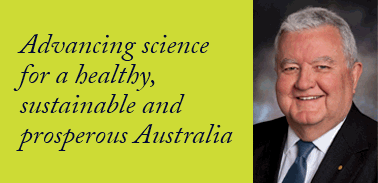|
News & Views item - October 2012 |
![]() Chief Scientist Addresses Australia-EU JSTCC Meeting, Brussels. (October
18,2012)
Chief Scientist Addresses Australia-EU JSTCC Meeting, Brussels. (October
18,2012)
The meetings of the Australia-European Union (EU) Joint Science and Technology
Cooperation Committee (JSTCC) are the principal mechanism for setting bilateral
Australia-EU research collaboration priorities and monitoring cooperation.
This past Tuesday, Australia's Chief Scientist, Professor Ian Chubb, addressed this year's meeting in Brussels and after the usual pleasantries, he told his audience: "Itís at gatherings like this that Iím reminded of just how important science is to the future of this planet and to all the people and all the animals and plants that live on it. And I am reminded just how common are the problems we face."
Below are excerpts of Professor Chubb's address.
Iíd like to touch on one of the ways we in Australia are working towards [determining the big problems demanding urgent attention through], a review last year that looked at focusing our publicly-funded research.
One of the key findings of the review was that it is critical for Australia to have a national, strategic approach and better coordination of effort and investment in research.
This led to the establishment of the Australian Research Committee (ARCom) and my appointment as its chairman.
It will consider all of the fundamental elements of the research system, including publicly-funded research, research workforce, infrastructure, collaboration and business research. How we can ensure that we allocate funding to issues that the nation must address, while not precluding quality research in other areas, including that which might seem a bit idiosyncratic, even off the wall.
Iíve just been in the U.S. and met representatives from the Office of
Management and Budget and the Office of Science and Technology Policy.
Their recent memorandum to all heads of department and agencies has set the
science and technology priorities for the 2014 budget and built on the
Presidentís Strategy for American Innovation. [It lists the following
eight categories:] Advanced manufacturing, Clean energy, Global climate change,
R&D for informed policy-making and management, Information Technology Research
and Development, Nanotechnology, Biological Innovation and Innovation and
commercialisation.
I am sure that the grand challenges that face us in Australia are similar, as are those that face Europe... And Iím pleased to say that Australia on average performs well in international collaboration... more than 40% [of publications which included an Australian] were co-authored with international collaborators.
Late last year, the Australian Academy of Science, released its paper Ė Australian Science In A Changing World: Innovation Requires Global Engagement. It speaks of the need for Australia to remain engaged with our scientific partners here in Europe... [One example] is that Australia is the first Associate Member of the European Molecular Biology Laboratory (EMBL). EMBL is the most cited scientific institution outside the U.S. in molecular biology and genetics, with an extremely high impact of an average of 66.02 citations per paper. Initiated in 2008 and running until 2014, Australiaís Associate Member status allows our institutions to benefit from activities such as funded research positions, collaborative ventures and the formation of research institutes.
The world needs science now, possibly more than ever. and if we are to give this world a better future than otherwise might be the case, I suggest that most problems, not all but most, will be confronted by teams working across disciplinary boundaries and across international borders. And the commitment from all the parties has to be there to meet them, head on.
___________________________________________________________
To download a PDF of the speech click
here![]() .
.